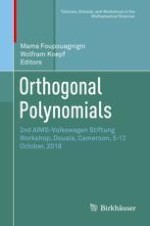This book presents contributions of international and local experts from the African Institute for Mathematical Sciences (AIMS-Cameroon) and also from other local universities in the domain of orthogonal polynomials and applications. The topics addressed range from univariate to multivariate orthogonal polynomials, from multiple orthogonal polynomials and random matrices to orthogonal polynomials and Painlevé equations.
The contributions are based on lectures given at the AIMS-Volkswagen Stiftung Workshop on Introduction of Orthogonal Polynomials and Applications held on October 5–12, 2018 in Douala, Cameroon. This workshop, funded within the framework of the Volkswagen Foundation Initiative "Symposia and Summer Schools", was aimed globally at promoting capacity building in terms of research and training in orthogonal polynomials and applications, discussions and development of new ideas as well as development and enhancement of networking including south-south cooperation.
